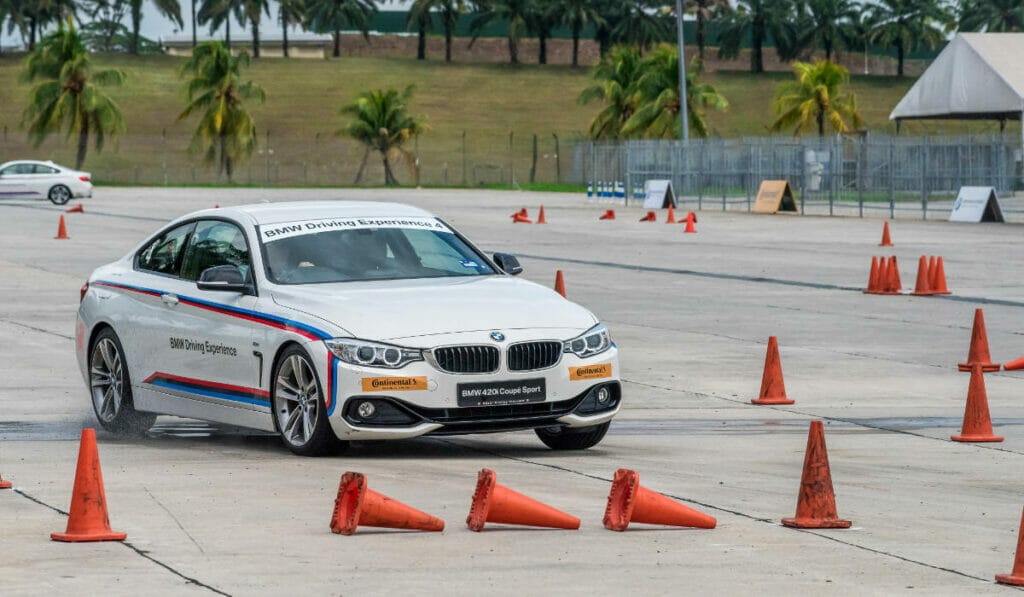What does 10km/h mean to you? On the highways, driving at 110km/h or 120km/h might just mean the difference between whether or not the Automated Enforcement System (AES) cameras take a very expensive snapshot of your car. But, say you are going into a corner and, suddenly, unforeseen circumstances (of which there are many), forces you to hit the brakes hard. Then, that 10km/h difference could very well decide whether you manage to control your car going into that corner, or lose it and ultimately end up in an accident. This is what BMW’s Driving Experience is designed to do: it shows you, in a controlled environment, what a seemingly innocuous speed variation can mean in an emergency situation.
Every year, BMW organises driving experiences at the Sepang International Circuit (SIC) for people who are serious about becoming better drivers. Seeing as how the German marque makes cars that typically pack some serious horsepower under the hoods, it only makes sense that it would want to teach customers how to properly hold the reins. There are two levels to this driving experience, with the first being an Advanced Module that really gets down to basics. Even for those who have been driving for decades, there is a good chance you’ll find out that your sitting position and the way you hold your steering wheel have been way off. This is also where BMW arranges practical exercises in typical traffic and hazard conditions – what happens when you have to brake and steer at 50km/h and at 60km/h.

Once you’ve completed the Advanced Module, you’re free to enrol in BMW’s two-day Intensive Module, and this is where things start to get really exciting and, to be honest, a little competitive. Where the first module aimed to get you familiarised with what to do with the car in case of an emergency, the second really gets the adrenaline pumping by focusing on driving the way the professionals do. This means, emergency manoeuvres at higher speeds, learning the racing lines, and finding the most efficient route in and out of each corner. To top it all off, you get to do it on the SIC, on the same corners as seen on TV.
Each year, BMW changes the cars you get to take onto the track and, thankfully for me, this year it was the 4-Series Coupé, the BMW 420i Coupé Sport, to be exact. After half a day of refreshing the basics and doing more drills on emergency driving manoeuvres, we finally got to don our helmets, strap ourselves in and have a spirited drive on the full Sepang track. As you could probably guess, watching race cars on TV and actually driving down the track is a phenomenally different experience. There are inclines and declines that can hardly be seen on-screen and there are even different cambers to each turn, forcing you to pretty much memorise where to brake, steer and, my favourite, where to start leaning on the throttle.
You go from seeing the corners as just another turn to numbered, structured parts of a whole and, with the help of very capable instructors, you learn the course. Turn 1: hard brake, turn in then immediately shift the steering for turn 2. Roll into Turn 3, lean on the power, so on and so forth. You then get a chance to drive behind instructors and even a session where the tables are turned and you have trained professionals right on your tail egging you on to driving faster while teaching you what you are doing wrong; it’s adrenaline pumping stuff. At the end of the two days, you get to take everything you have learned and tackle a section of the track on your own; and, to give you a little taste of competition, the fastest time recorded will win something special from BMW, in addition to the admiration of your peers.

To be honest, even after going through the Advanced Module I didn’t consciously feel like a better driver, but coming into the Intensive Module of the BMW Driving Experience, I started to notice how I wasn’t knocking down cones during the exercises (in the first module, I devastated countless innocent rubber cones), and I think it’s because once you’ve experience what you need to do in an emergency, your body adapts and remembers that feeling and, without even thinking about it, it becomes more of a reflex. If knowing is half the battle, practice is undoubtedly the key half to a whole.



